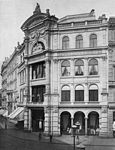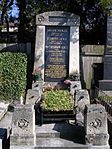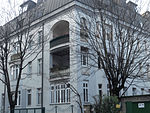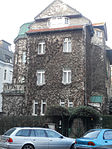Oskar Marmorek
Oskar Adolf Marmorek (born April 9, 1863 in Peskenstein , Galicia ; died April 7, 1909 in Vienna ) was an Austrian architect and Zionist .
Live and act
Oskar Marmorek was born in Galicia as the oldest of five children. His younger brothers were Alexander Marmorek and Schiller Marmorek . The family changed their place of residence within Galicia a few times before moving to Vienna in 1875. From 1880 Oskar Marmorek attended the building school of the Technical University , where Karl König and Rudolf Weyr were among his teachers. In 1887 he finished his studies and immediately won a competition with Philipp Herzog for a house in the cottage district . He became a member of the Austrian Association of Engineers and Architects and then went on several trips.
In Paris he worked on the world exhibition in 1889 , where he was so impressed by the Fontaine Lumineuse , a colorfully illuminated fountain , that a year later he designed a scaled-down version for the Vienna Prater . This made him so successful that he became one of the most sought-after exhibition architects, for example for the Alt-Wien exhibition , also in the Prater in 1892. In 1895 he was commissioned by Gabor Steiner to design the Venice exhibition in Vienna , for which he designed constantly changing buildings. From that year he also published the magazine Neubauten und Concurrenzen in Austria and Hungary . This magazine later spread the Wagner school. Although Marmorek was not a student of Otto Wagner , his later works showed quite a bit of influence from Wagner, which Wagner was very pleased with.
Also in 1895 Marmorek met Theodor Herzl for the first time . After the appearance of the Jewish state , he finally joined the Zionist movement and became one of Herzl's best friends, who in 1897 (Herzl's letter to Marmorek May 18, 1897) saw him as “the first master builder of the Jewish Renaissance” and an extended one Series of articles in the newly founded world . In Herzl's key novel Altneuland , Oskar Marmorek and his brother, the doctor Alexander , appear as architect and professor Dr. Steineck before. After Marmorek married the painter Nelly Schwarz in 1897, he organized the first Zionist congress in Basel with Herzl and Max Nordau . At most of the following congresses he gave a presentation on the development of Zionism in different parts of the world.
In 1898 Marmorek built the Nestroyhof in Vienna- Leopoldstadt for his father-in-law Julius Schwarz . In 1899 he helped found the Jewish Colonial Trust . In 1902 his most famous building, the Rüdigerhof in Margareten, was built . In 1903 he took part in the El Arish expedition, which was intended to research the suitability of this area on the Sinai Peninsula for settlement purposes. But the result was negative. As a result, Great Britain offers an area in Uganda . This split the Zionist movement into the “old Zionists” who wanted to examine this plan and the radical “young Zionists” who did not accept an area outside of Palestine. Marmorek was one of the ancient Zionists. Although Herzl declared him responsible for all architectural questions relating to Zionism, he did not like Marmorek's plan for a congress center in Basel at all, so he drew his own design.
Marmorek is elected to the board of the religious community , which was dominated by assimilants at the time , but the conflicts with the Young Zionists, the death of Herzl and other companions and health problems intensified his existing depression . In 1909 he shot himself at the grave of his father in the Vienna Central Cemetery , where his grave is located today (old Israelite part, 1st gate; group 20, row 17b, no.5)
Works
| photo | Construction year | Surname | Location | description | Metadata |
|---|---|---|---|---|---|
| 1890 | Villa Wrchovszky in Grinzing |
Vienna 19 |
Annotation: |
|
|
| 1892 | Exhibition Alt Wien |
Prater, Vienna 2nd |
destroys the concert hall and shadow theater "Alt Wien" (The Hohe Markt before the second Turkish siege). Tonhalle and shadow theater for the Int. Music and theater exhibition |
|
|
| 1894 | “International village” for the exhibition on food for the people, food for the army, rescue services and transport |
Vienna |
destroyed Note: Competition 1st prize |
|
|
| 1895 | villa |
Löver krt., Sopron, Hungary |
|
||
| 1895 | Villa Goldberger |
Unterach am Attersee, Upper Austria location |
|
||

|
1895 |
Venice entertainment establishment in Vienna |
Vienna 2nd |
destroyed Note: between Exhibition Street and Prater Hauptallee |
|
| 1896 | Villa Ludwig Egyedi |
Budapest, Hungary |
|
||

|
1896 | Arthur Egyedi Palace |
Benczúr Gyula utca 27, Budapest, Hungary Location |
|
|

|
1896 | “Ös-Budavara” (replica of the old Ofen Castle) and pavilion of the AG Dynamit Nobel for the Millennium Exhibition in Budapest |
Budapest, Hungary |
destroyed |
|
| 1897 | Round painting building in the Prater |
Vienna 2nd |
destroyed |
|
|

|
1897-1898 | Extension to the sanatorium |
Zlatna Hory , Czech Republic location |
|
|

|
1898 |
Living u. Nestroy-Hof office building |
Vienna 2, Nestroyplatz 1 location |
|
|
| 1898 | Pavilions f. Scheffel and Berger Volk & Cie. for the Kaiser anniversary exhibition in the Prater |
Vienna 2nd |
destroyed |
|
|
| 1900 | Villas |
Vienna 18, Lannerstraße 28 and 30 location |
changed Note: (changed) |
|
|
| 1900 | Tomb for Dr. Josef Marmorek |
Zentralfriedhof, Vienna 11 |
|
||

|
1900 |
Lighting and decoration of the "Haas House" |
Vienna 1., Stock-im-Eisen-Platz location |
destroyed On the occasion of the 70th birthday of Emperor Franz-Joseph I. |
|

|
1902 |
Residential and commercial building "Rüdiger-Hof" |
Vienna 5, Hamburgerstraße 20 location |
Note: formerly Wienstraße 28 |
|

|
1902 | Residential and commercial buildings |
Vienna 6, Windmühlgasse 30 location |
|
|

|
1902 | Residential and commercial buildings |
Vienna 6, Windmühlgasse 32 location |
|
|

|
1904 | Grave of Theodor Herzl |
Döblinger Friedhof |
|
|

|
1904 | Rental villa |
Vienna 2, Böcklinstraße 59 Location |
|
|
| 1904 | Rental house |
Vienna 7, Lindengasse 4 location |
|
||
| around 1904 | Rental house |
Vienna 9, Säulengasse 7 / Dreihackengasse 6 location |
|
||

|
1905 | Rental house "To the 3 Larks" |
Vienna 8, Lerchengasse 3–5 location |
|
|

|
1905 | Rental house |
Vienna 2, Floßgasse 4 location |
Note: rebuilt in 1956, simplified |
|

|
1905-1906 | Living u. Factory building |
Vienna 7, Schottenfeldgasse 65 location |
|
|
| 1905 |
Reconstruction of the Leopoldstadt Temple |
Location |
|
||

|
1906 | Living u. Office building |
Vienna 8, Florianigasse 4 / Wickenburggasse 8 location |
|
|

|
1906 |
Jet fountain, conversion to Fontaine lumineuse |
Location |
Note: Listed in azw under 1890 and destroyed |
|
| 1906 | Living u. Commercial building group |
Vienna 17, Hernalser Hauptstraße 182, 184, 186, 188 and Dr Josef-Resch-Platz 1, 3 u. 4 location |
Note: No. 184 totally rebuilt. Dr. Josef-Resch-Platz 1 demolished |
|
|

|
1906-1908 | Rental house |
Vienna 19, Gebhardtgasse 6–8 location |
|
|

|
1907 | former ritual bath for cult community "Mikwah" |
Vienna 2, Floßgasse 14 location |
destroyed Note: plaster decor chipped |
|

|
1908 | Rental house |
Vienna 6, Stumpergasse 14 location |
|
|

|
1908 | Rental villa |
Vienna 2, Böcklinstraße 61 location |
Note: formerly Valeriestraße 23, facade decor partially chipped |
|

|
1908 | Rental villa |
Vienna 2, Böcklinstraße 63 Location |
Note: formerly Valeriestraße 25, facade decor chipped |
|

|
1909 | Living u. Factory building |
Vienna 18, Mitterberggasse 11 Location |
Note: changed and converted into a residential building from 1986–88 |
|
literature
- Marmorek Oskar. In: Austrian Biographical Lexicon 1815–1950 (ÖBL). Volume 6, Verlag der Österreichischen Akademie der Wissenschaften, Vienna 1975,ISBN 3-7001-0128-7, p. 104 f. (Direct links on p. 104 , p. 105 ).
- Markus Kristan: Oskar Marmorek - Zionist and Architect. Böhlau Verlag, Vienna 1996, ISBN 3-205-98475-7 .
- Ita Heinze-Greenberg: Europe in Palestine. The architects of the Zionist project 1902–1923. gta Verlag, Zurich 2012, ISBN 978-3-85676-230-8 .
Web links
- Oskar Marmorek. In: Architects Lexicon Vienna 1770–1945. Published by the Architekturzentrum Wien . Vienna 2007.
- Oskar Marmorek in the Vienna History Wiki of the City of Vienna
Individual evidence
| personal data | |
|---|---|
| SURNAME | Marmorek, Oskar |
| ALTERNATIVE NAMES | Marmorek, Oskar Adolf (full name) |
| BRIEF DESCRIPTION | Austrian architect, Zionist |
| DATE OF BIRTH | April 9, 1863 |
| PLACE OF BIRTH | Pieskowa Skała |
| DATE OF DEATH | April 7, 1909 |
| Place of death | Vienna |

